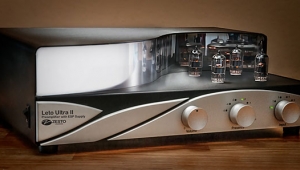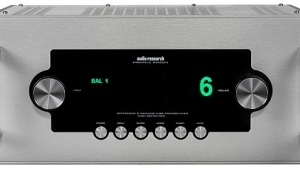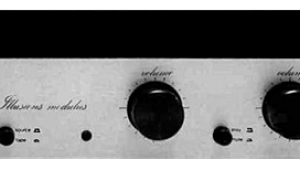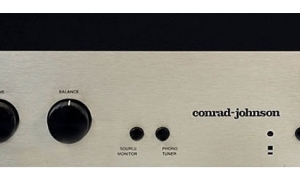| Columns Retired Columns & Blogs |
Musical Fidelity Tri-Vista kWP preamplifier & Tri-Vista kW Monobloc power amplifier
Thoughts of power, domination, and audio road-rage enter one's mind when contemplating Musical Fidelity's SUV-like, limited-edition, 20th-anniversary offerings (footnote 1). (Only 75 sets of kWPs and kWs will be made.) The gleaming, brushed-aluminum, two-box, oversized, overweight Tri-Vista kWP preamp is fortress-like—the "kWP" looks as if chiseled into the faceplate by grimy, sweaty hands. Each of its boxes weighs almost 56 lbs. The unit's milled-aluminum remote control, the size of a Volkswagen Microbus and looking like something Fred Flintstone might wield, must weigh over 5 lbs. The kWP outputs more juice than many power amps: 55V, with 20 amps of peak-peak instantaneous current!
Footnote 1: Disclaimer: Musical Fidelity has purchased an advertisement on my website.—Michael Fremer
But that's a mere trickle compared to the flood of power delivered by the bank-vault-like Tri-Vista kW Monobloc power amp, with its egg-slicer cooling fins running the full length and width of their sides, and Gort-ish blue LED slits. These 19" by 18" by 12" boxes weigh almost 95 lbs each—but despite that size and weight, there was no room left inside for the AC supplies. They're in yet another box, which weighs 94 lbs and which is shared by a pair of kWs. (Those in love with power can add a second supply for full dual-mono operation.)
Musical Fidelity Tri-Vista kWP: $11,995
Some will find the kWP preamplifier's outlandishly sized knobs and remote control cartoonish. But the kWP's build and design aspirations are no laughing matters. The dual-mono configuration features each channel in its own chassis within the main unit. Power from the PSU gets to the control and amplification box via two sets of multi-pin connector cables per channel: one set for low voltage, one for main power. There are five sets of single-ended line-level inputs (Tape, Aux, Tuner, SACD, CD), two configurable Phono inputs (moving-magnet, moving-coil) selectable via a front-panel button, and, for that increasingly rare breed of three-head analog tape-deck enthusiasts, a dedicated tape loop. Musical Fidelity also provides two sets of preamp outputs for biamping—in case you want to own two sets of $23,995 kWs.
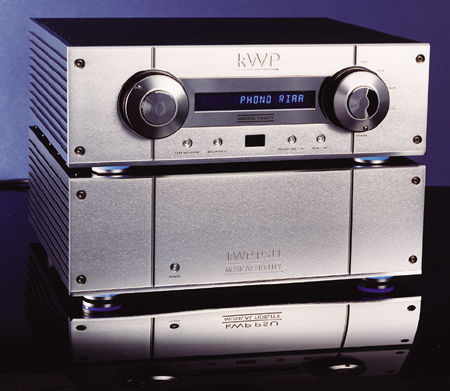
"A proper phono section" is how MF's Antony Michaelson describes what's in the kWP. It includes a rear-panel loading choice of 10 or 100 ohms in the MC input (with capacitance fixed at 470pF), and a four-switch adjustment for MM that allows you to select a variety of capacitive loads at a fixed, standard resistive load of 47k ohms. The choice of 10 or 100 ohms is pretty limited, and if you like running your MC minimally loaded at 47k ohms, you're out of luck—but 100 ohms is about right for many MC enthusiasts. Another feature is a choice of RIAA and IEC equalization. The IEC choice is idnetical to the RIAA curve in the treble and midrange but rolls off the low bass to minimize rumble.
While both preamp and power amp are part of Musical Fidelity's limited-edition Tri-Vista series, only the preamp sports the tiny triode tubes found in the Tri-Vista SACD player. These tubes are so robust and long-lived that the preamp can be left on all the time.
Musical Fidelity Tri-Vista kW Monobloc: $23,995
In the looks department, the kW doesn't hold a 1000W candle to the magnificently turned-out Pass Labs XA 160 that I reviewed last November—but appearance isn't everything, and its imposing size and scale make the nicely finished, all-business kW look pretty good.
Each kW chassis has a single-ended input and is rated at 1000W into 8 ohms, 1800 into 4 ohms, and a speaker-boggling 3000W into 2 ohms. Instantaneous peak output is claimed to be a frightening 5000W, with a peak current potential of ±200 amps and output voltage of around 130 amps. The Tri-Vista kWs can probably supply more juice than Florida.
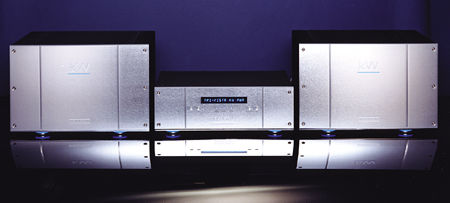
A three-box, two-channel kW rig is physically and electrically intimidating. Along with a hefty implementation of MF's preferred choke regulation and a class-A driver stage, each amplifier has 40 output devices, meaning MF has taken the opposite tack to Pass Labs' minimalist approach. The kWs draw their power from the shared power supply via three cables per channel: two low-voltage, including control functions, and one mains connection. Three pairs of hefty but normal-diameter binding posts are provided, which means that, unlike with the Nu-Vista 300's original binding posts, spade lugs are welcome. Three pairs? These amps are so powerful, you could probably biwire your own speakers, then drive your next-door neighbor's speakers with the third set.
All controls are on the kWs' power-supply unit, which features a pair of 2kVA transformers and a front-panel vacuum-fluorescent display that can tell you how many hours the amps have been used, and even the unit's serial number. Each power-supply channel has its own 20-amp IEC AC connector. Front-panel controls include On and Off, a brightness adjustment button for the display, and an Info button, which toggles through the choices. Three LEDs confirm left, right, and PSU power.
Connections, Cautions, Control
Once, while a counselor at a summer camp, I built a three-stage, solid-fuel Estes rocket that had to be ignited electronically, with a car battery. Almost the entire camp assembled for the event, standing in a vast circle at a safe distance from the missile. Everyone counted down excitedly from "10," and at "Zero!" my shaking finger pushed the button. The rocket lifted off the pad about half a foot, then leaned over 90 degrees and accelerated full throttle on a track parallel to the ground, heading straight for some campers. Fortunately, they scattered in time, and the rocket crashed into a tree and disintegrated. That came to mind as I helped Musical Fidelity's Antony Michaelson connect the various cords and wires of the mega kW power amps.
"Because the kW will NOT CLIP, any inadvertent electrical noise will be hugely amplified by the kW. As the kW can deliver 5000W peaks, a mistake could vaporize the internals of your loudspeakers. At the factory, we ALWAYS switch off the kW for at least five minutes before we change anything. So should you. You have been warned."
That's a section of the instruction manual's front-page greeting. Scary? You bet. No wonder the installation reminded me of an episode of Fear Factor. When everything was wired up correctly and securely and it was time to launch the amps, Michaelson still seemed concerned. I can only imagine some of the factory mishaps on the way to the kW's final design.
Footnote 1: Disclaimer: Musical Fidelity has purchased an advertisement on my website.—Michael Fremer
- Log in or register to post comments







